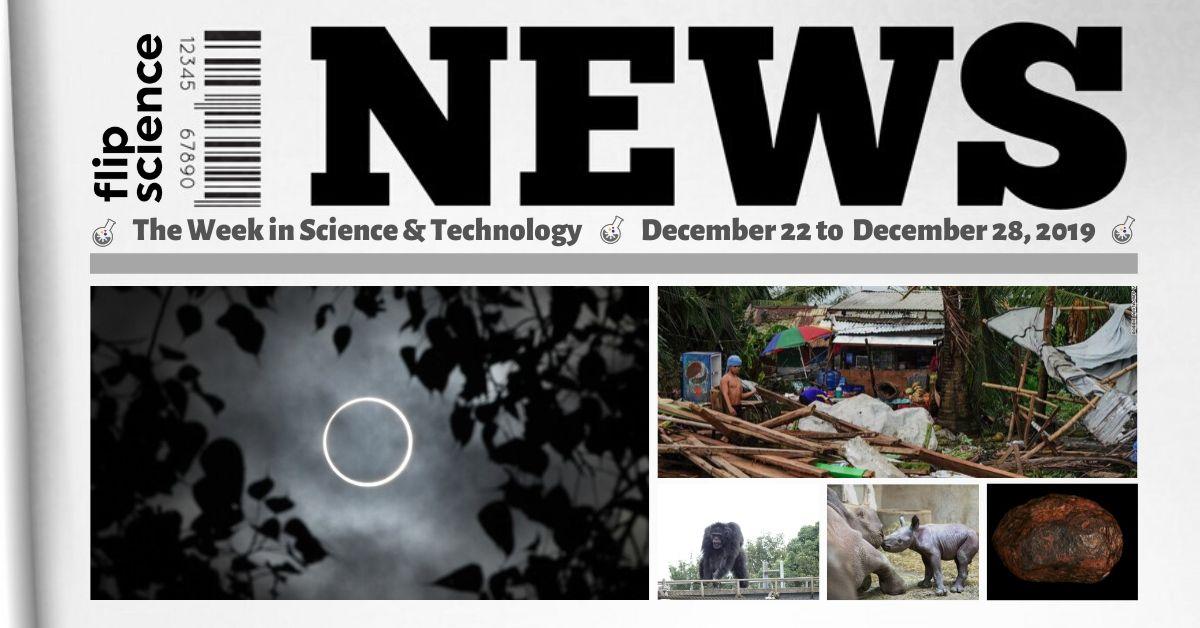ICYMI: Science and technology updates from December 22 to 28, 2019.
A ring of fire in the sky: Pinoys witness ‘rare’ annular solar eclipse
From Rappler:
Skywatchers in the Philippines and all around the world were able to witness a rare astronomical event as an annular solar eclipse graced the sky on Thursday, December 26.
According to the Philippine Atmospheric, Geophysical and Astronomical Services Administration, an annular solar eclipse occurs when the moon, while at its farthest distance from the earth, enters the point in its orbit located directly in front of the sun.
This distance makes the moon appear smaller and unable to completely obscure the view of the sun, causing a “ring of fire” effect or annular – a thin crown of light around the moon.
Ursula exits PH, leaves 35 dead
From GMA News Online:
Typhoon Ursula left the Philippines Saturday morning, but not before causing the deaths of 35 individuals, the National Disaster Risk Reduction and Management Council (NDRRMC) said in a 6 p.m. situational report.
Most fatalities were recorded in Region VI with 20 deaths, followed by Region VIII with eight deaths, MIMAROPA with six deaths, while Region VII had a single fatality.
Twenty-two individuals were also injured due to Ursala, while 14 people were reported missing in Regions VI, VII , VIII, and MIMAROPA.
Bananas on the dance floor: Music can make chimps bust a move
From Phys.org:
A pair of researchers at Kyoto University has found that chimpanzees will spontaneously dance to music. In their paper published in Proceedings of the National Academy of Sciences, Yuko Hattori and Masaki Tomonaga describe observing spontaneous dancing in chimps and how one chimp behaved when tested on dancing tendencies.
Music tends to make people move. Whether tapping out a beat, swaying or outright dancing—people respond. Prior research has shown that some animals, such as cockatoos, tend to move when they hear music, too. In this new effort, the researchers built on a recent report of chimpanzees spontaneously dancing in a sort of conga line. They noted that prior research has also found that chimps engage in dance-like behaviors sometimes when it rains, or when they are near a waterfall.
Rare black rhino baby born on Christmas Eve
From The Washington Post:
He was not born in a manger, and there were no wise men, nor frankincense or myrrh. But the masses are still flocking to worship him.
Meet the Potter Park Zoo’s Christmas Eve miracle, a black rhino calf born at 5:40 a.m. on Dec. 24 in Lansing, Mich. “It’s a boy!” the zoo wrote in the calf’s birth announcement. The little guy does not yet have a name, but he has been collecting fans since before he was born. A video feed of his mother, 12-year-old Doppsee, broadcast his birth on the zoo’s Facebook page.
The baby rhino stood within an hour and a half of appearing in the world, nursed for the first time midmorning and has been the star of the zoo’s social media pages since. The calf appears healthy and has been bonding “behind the scenes” with Doppsee, according to a news release from the zoo. This is Doppsee’s first offspring — and the first time in the Potter Park Zoo’s 100-year existence that a black rhino has been born there.
Researchers find new naturally occuring mineral in mini-meteorite
From CNN.com:
Between 2015 and 2019, researchers discovered 31 new carbon minerals, most of them vividly colorful. Edscottite is one of the least flashy new finds, but it’s also the one that’s set geologists abuzz.
Edscottite is one of the phases iron goes through when it’s cooling down from a high temperature, as it’s smelted into steel. But the edscottite discovered in a tiny meteorite and officially named this year is the first to occur in nature.
The Wedderburn meteorite’s been sitting in Museums Victoria in Australia since it was found nearby in 1951, and researchers have sliced it open to search its contents just as long.
“We have discovered 500,000 to 600,000 minerals in the lab, but fewer than 6,000 that nature’s done itself,” Stuart Mills, Museums Victoria’s senior curator of geosciences, told Melbourne newspaper The Age.
References:
- https://www.rappler.com/science-nature/247595-ring-fire-annular-solar-eclipse-visible-december-26-2019
- https://www.gmanetwork.com/news/news/nation/720434/ursula-left-280-000-families-affected-ndrrmc-says/story/
- https://phys.org/news/2019-12-chimpanzees-spontaneously-music.html
- https://www.washingtonpost.com/science/2019/12/25/its-boy-meet-rare-black-rhino-baby-born-christmas-eve/
- https://edition.cnn.com/2019/12/26/world/new-mineral-discovered-edscottite-scn-trnd/index.html







